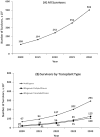Prevalence of hematopoietic cell transplant survivors in the United States
- PMID: 23906634
- PMCID: PMC3779514
- DOI: 10.1016/j.bbmt.2013.07.020
Prevalence of hematopoietic cell transplant survivors in the United States
Abstract
Advances in hematopoietic cell transplantation (HCT) have led to an increasing number of transplant survivors. To adequately support their healthcare needs, there is a need to know the prevalence of HCT survivors. We used data on 170,628 recipients of autologous and allogeneic HCT reported to the Center for International Blood and Marrow Transplant Research from 1968 to 2009 to estimate the current and future number of HCT survivors in the United States. Stacked cohort simulation models were used to estimate the number of HCT survivors in the United States in 2009 and to make projections for HCT survivors by the year 2030. There were 108,900 (range, 100,500 to 115,200) HCT survivors in the United States in 2009. This included 67,000 autologous HCT and 41,900 allogeneic HCT survivors. The number of HCT survivors is estimated to increase by 2.5 times by the year 2020 (242,000 survivors) and 5 times by the year 2030 (502,000 survivors). By 2030, the age at transplant will be < 18 years for 14% of all survivors (n = 64,000), 18 to 59 years for 61% survivors (n = 276,000), and 60 years and older for 25% of survivors (n = 113,000). In coming decades, a large number of individuals will be HCT survivors. Transplant center providers, hematologists, oncologists, primary care physicians, and other specialty providers will need to be familiar with the unique and complex health issues faced by this population.
Keywords: Allogeneic; Autologous; Hematopoietic cell transplantation; Prevalence; Survivors.
Copyright © 2013 American Society for Blood and Marrow Transplantation. Published by Elsevier Inc. All rights reserved.
Conflict of interest statement
None of the authors has any relevant financial conflicts of interest to disclose. Navneet Majhail had full access to all of the data in the study and had final responsibility for the integrity of the data, the accuracy of the data analysis, and the responsibility for the decision to submit for publication. Authors designed research (all authors), collected data (NM), performed statistical analysis (LT, KK), interpreted data (all authors), drafted the manuscript (NM, LT), and critically revised the manuscript (all authors). All authors have reviewed and approved the final version of the manuscript.
Figures



Similar articles
-
Late effects in hematopoietic cell transplant recipients with acquired severe aplastic anemia: a report from the late effects working committee of the center for international blood and marrow transplant research.Biol Blood Marrow Transplant. 2012 Dec;18(12):1776-84. doi: 10.1016/j.bbmt.2012.06.018. Epub 2012 Aug 1. Biol Blood Marrow Transplant. 2012. PMID: 22863842 Free PMC article.
-
Prospective Validation of the Predictive Power of the Hematopoietic Cell Transplantation Comorbidity Index: A Center for International Blood and Marrow Transplant Research Study.Biol Blood Marrow Transplant. 2015 Aug;21(8):1479-87. doi: 10.1016/j.bbmt.2015.04.004. Epub 2015 Apr 7. Biol Blood Marrow Transplant. 2015. PMID: 25862591 Free PMC article.
-
Surviving the cure: long term followup of hematopoietic cell transplant recipients.Bone Marrow Transplant. 2013 Sep;48(9):1145-51. doi: 10.1038/bmt.2012.258. Epub 2013 Jan 7. Bone Marrow Transplant. 2013. PMID: 23292238 Review.
-
Hematopoietic Stem Cell Transplant Recipients Surviving at Least 2 Years from Transplant Have Survival Rates Approaching Population Levels in the Modern Era of Transplantation.Biol Blood Marrow Transplant. 2020 Sep;26(9):1711-1718. doi: 10.1016/j.bbmt.2020.03.005. Epub 2020 Mar 16. Biol Blood Marrow Transplant. 2020. PMID: 32194285
-
Alloreactivity as therapeutic principle in the treatment of hematologic malignancies. Studies of clinical and immunologic aspects of allogeneic hematopoietic cell transplantation with nonmyeloablative conditioning.Dan Med Bull. 2007 May;54(2):112-39. Dan Med Bull. 2007. PMID: 17521527 Review.
Cited by
-
Cardiovascular Considerations in Patients Undergoing Hematopoietic Cell Transplantation.Curr Treat Options Oncol. 2024 Aug;25(8):1027-1037. doi: 10.1007/s11864-024-01240-1. Epub 2024 Jul 25. Curr Treat Options Oncol. 2024. PMID: 39052206 Free PMC article. Review.
-
Burden of Long-Term Morbidity Borne by Survivors of Acute Myeloid Leukemia Treated With Blood or Marrow Transplantation: The Results of the BMT Survivor Study.J Clin Oncol. 2022 Oct 1;40(28):3278-3288. doi: 10.1200/JCO.21.02829. Epub 2022 Jun 22. J Clin Oncol. 2022. PMID: 35731989 Free PMC article.
-
Survivor and Clinician Assessment of Survivorship Care Plans for Hematopoietic Stem Cell Transplantation Patients: An Engineering, Primary Care, and Oncology Collaborative for Survivorship Health.Biol Blood Marrow Transplant. 2019 Jun;25(6):1240-1246. doi: 10.1016/j.bbmt.2019.02.003. Epub 2019 Feb 11. Biol Blood Marrow Transplant. 2019. PMID: 30763727 Free PMC article.
-
Late infectious complications in hematopoietic cell transplantation survivors: a population-based study.Blood Adv. 2020 Apr 14;4(7):1232-1241. doi: 10.1182/bloodadvances.2020001470. Blood Adv. 2020. PMID: 32227211 Free PMC article.
-
Cardiovascular perspectives on stem cell transplant and Car-T cell therapy: The old and the new for assessment and management.Am Heart J Plus. 2022 Aug 24;22:100198. doi: 10.1016/j.ahjo.2022.100198. eCollection 2022 Oct. Am Heart J Plus. 2022. PMID: 38558902 Free PMC article. No abstract available.
References
-
- Altekruse SF, Kosary CL, Krapcho M, et al. SEER Cancer Statistics Review. National Cancer Institute; Bethesda, MD: 1975–2007. http://seer.cancer.gov/csr/1975_2007/, based on November 2009 SEER data submission, posted to the SEER web site, 2010 (accessed 01/01/2013)
-
- Pasquini MC, Wang Z. Current use and outcome of hematopoietic stem cell transplantation: CIBMTR Summary Slides. 2011 Available at: http://www.cibmtr.org.
-
- Horan JT, Logan BR, Agovi-Johnson MA, et al. Reducing the risk for transplantation-related mortality after allogeneic hematopoietic cell transplantation: how much progress has been made? J Clin Oncol. 2011;29(7):805–813. doi: 10.1200/JCO.2010.32.5001. Prepublished on 2011/01/12 as. - DOI - PMC - PubMed
Publication types
MeSH terms
Grants and funding
LinkOut - more resources
Full Text Sources
Other Literature Sources

